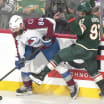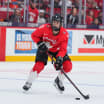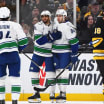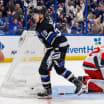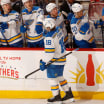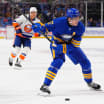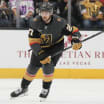BUFFALO --They are so different, yet so similar.
Steven Stamkos, the chatty center from Canada who is the undisputed captain and leader.
Nikita Kucherov, the quiet wing from Russia who lets his stick do his talking for him.
Victor Hedman, the behemoth defenseman (6-foot-6, 235 pounds) from Sweden who truly is the gentle giant of the NHL.
Big three have Lightning atop NHL standings, thinking Stanley Cup
Stamkos, Kucherov, Hedman give Tampa Bay core skaters needed to win championships

© Getty Images
By
Mike Zeisberger
NHL.com Staff Writer
RELATED: [Trophy Tracker: Kucherov favorite for Hart | Lightning end skid, beat Red Wings]
Together, these players form the backbone of the Tampa Bay Lightning -- at least the ones who don't wear pads and a mask.
And on this particular day, with practice having finished at KeyBank Center, they are discussing which one of them has the hardest shot.
"It's Kuch," Stamkos says with authority.
"Nah, it's Stammer," counters Kucherov.
"I'll tell you one thing," Stamkos says. "It's not Heddy."
They burst into laughter.
"Well, it's true," Stamkos says.
At least they agree on something.
"I'd like to say me, but it's close between Stammer and Kuch," Hedman admits.
"Being out there with those two guys on the power play, I try to be a threat. Teams are going to try to concentrate on those other two guys."
Opponents have been concentrating on all three of them all season long, with minimal success.
After 42 games, the three find themselves as leading candidates to win some of the top individual honors in the sport.
Kucherov, with 59 points (27 goals, 32 assists), and Stamkos, with 51 points (17 goals, 34 assists) are battling for the scoring title, and each is in the conversation for the Hart Trophy as League MVP. Hedman, who has 31 points (five goals, 26 assists) is vying for his first Norris Trophy as the top defenseman in the NHL in what should be a tight race with the likes of Drew Doughty of the Los Angeles Kings and Alex Pietrangelo of the St. Louis Blues.
With winning the Stanley Cup as the immediate goal, Tampa Bay general manager Steve Yzerman has signed Hedman through 2025, Stamkos through 2024, and Kucherov through 2019.
For coach Jon Cooper, the first-half performance of his three core skaters has been key to his team's first-half record of 30-9-3, the best in the NHL through 42 games.
"Any team that's going to have long-term success -- not just short term -- you need to have that core in place," Cooper said. "And I think Steve [Yzerman] has done a great job of identifying our core and then locking them up to be here long term. Those are the names that roll off the tongue -- Stamkos, Kucherov, Hedman.
"Sure, you'd be remiss not to mention the Johnsons, the Palats, the other guys who help make this a team," Cooper said about forwards Tyler Johnson and Ondrej Palat. "It's a team game, and you can't win with just two or three individuals. And no team can have success without great goaltending, which Andrei Vasilevskiy has given us.
"Still, this group has had a lot of success because of that (Stamkos-Kucherov-Hedman core)."
Cooper has a point when he says you can't win without good goaltending. But history shows that recent Stanley Cup winners require their own big three -- two lethal forwards and a stud defenseman.
"In every sport you need to have those guys where you build around them," Los Angeles Kings forward Anze Kopitar said.
The 2006-07 Anaheim Ducks had Teemu Selanne and Paul Kariya up front and Scott Niedermayer on the blueline; they had Chris Pronger, another future Hockey Hall of Famer, on defense as well.
The 2007-08 Detroit Red Wings sported the dynamic forward duo of Pavel Datsyuk and Henrik Zetterberg, as well as defenseman Nicklas Lidstrom, chosen as one of the 100 Greatest NHL Players presented by Molson Canadian in January 2017.
In 2008-09, Sidney Crosby, Evgeni Malkin and rookie defenseman Kris Letang won the first of their three Stanley Cup titles with the Pittsburgh Penguins.
The 2009-10 season featured the Chicago Blackhawks trio of Patrick Kane, Jonathan Toews and Duncan Keith -- all named to the 100 Greatest NHL Players -- winning the first of their three Cups, the others coming in 2013 and 2015.
In 2010-11, the Boston Bruins won their first Stanley Cup title in 39 years with defenseman Zdeno Chara and forwards Patrice Bergeron and David Krejci leading the way.
The 2011-12 Kings had a big three of forwards Kopitar, Jeff Carter and Doughty. They would combine to win another Cup in 2014.
Aside from goaltending, Crosby buys into the notion that successful postseason teams usually have a big three. He does admit that the 2017 Penguins proved to be an exception to the rule, using a defense-by-committee approach with Letang out for the playoffs because of injury.
"It's really important," Crosby said. "You have to have the heart of your core to be successful. And with the salary cap, it's hard to keep the foundation of your team together. It's important.
"Sure, it doesn't guarantee anything. You've got to find ways. It's bounces, it's matchups … There's no guarantees. But the better off you can keep the group together, the better chance you give yourself."
Lightning forward Chris Kunitz sees similarities between the Tampa Bay trio of Stamkos-Kucherov-Hedman and Pittsburgh's successful foundation of Crosby-Malkin-Letang. Kunitz won the Stanley Cup three times in Pittsburgh before joining the Lightning as a free agent July 1.
"It's all about having game-breakers that have the ability to take over games," Kunitz said. "And through the first half of the season, that's exactly what's happened; they've taken over games. Goaltending's a given, it's the biggest need a team has. But having key players at pivotal positions like a stud defenseman and a tandem up front generates the type of on-ice influence you need."
That Lightning have all of that in Stamkos, Kucherov and Hedman. Now it's up to the big three to see if postseason success will follow.
